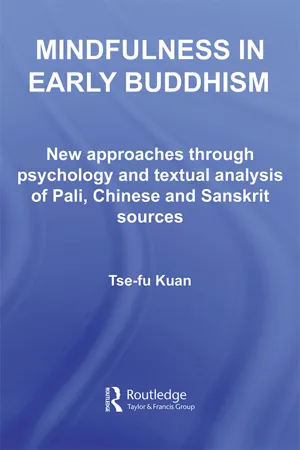
Mindfulness in Early Buddhism
New Approaches through Psychology and Textual Analysis of Pali, Chinese and Sanskrit Sources
- 238 pages
- English
- ePUB (mobile friendly)
- Available on iOS & Android
Mindfulness in Early Buddhism
New Approaches through Psychology and Textual Analysis of Pali, Chinese and Sanskrit Sources
About this book
This book identifies what is meant by sati (smrti), usually translated as 'mindfulness', in early Buddhism, and examines its soteriological functions and its central role in the early Buddhist practice and philosophy. Using textual analysis and criticism, it takes new approaches to the subject through a comparative study of Buddhist texts in Pali, Chinese and Sanskrit. It also furnishes new perspectives on the ancient teaching by applying the findings in modern psychology. In contemporary Buddhism, the practice of mindfulness is zealously advocated by the Theravada tradition, which is the only early Buddhist school that still exists today. Through detailed analysis of Theravada's Pali Canon and the four Chinese Agamas - which correspond to the four main Nikayas in Pali and belong to some early schools that no longer exist - this book shows that mindfulness is not only limited to the role as a method of insight (vipassana) meditation, as presented by many Theravada advocates, but it also has a key role in serenity (samatha) meditation. It elucidates how mindfulness functions in the path to liberation from a psychological perspective, that is, how it helps to achieve an optimal cognitive capability and emotional state, and thereby enables one to attain the ultimate religious goal. Furthermore, the author argues that the well-known formula of ekaayano maggo, which is often interpreted as 'the only way', implies that the four satipa.t.thaanas (establishments of mindfulness) constitute a comprehensive path to liberation, and refer to the same as kaayagataa sati, which has long been understood as 'mindfulness of the body' by the tradition. The analysis shows that kaayagataa sati and the four satipa.t.thaanas are two different ways of formulating the teaching on mindfulness according to different schemes of classification of phenomena.
Frequently asked questions
- Essential is ideal for learners and professionals who enjoy exploring a wide range of subjects. Access the Essential Library with 800,000+ trusted titles and best-sellers across business, personal growth, and the humanities. Includes unlimited reading time and Standard Read Aloud voice.
- Complete: Perfect for advanced learners and researchers needing full, unrestricted access. Unlock 1.4M+ books across hundreds of subjects, including academic and specialized titles. The Complete Plan also includes advanced features like Premium Read Aloud and Research Assistant.
Please note we cannot support devices running on iOS 13 and Android 7 or earlier. Learn more about using the app.
Information
Table of contents
- Cover Page
- Title Page
- Copyright Page
- Acknowledgements
- Abbreviations
- Map
- Introduction
- 1 Mindfulness in soteriology: Transformation of cognition and emotion
- 2 Types and functions of mindfulness
- 3 Mindfulness in methodical meditation
- 4 Kāyagatā sati: Mindfulness directed to the experiencer
- 5 The four Satipatthānas: Mindfulness as a comprehensive path
- Conclusion
- Appendix 1 An annotated translation of the Sarvāstivāda version of the Sutta
- Appendix 2 An annotated translation of the Sarvāstivāda version of the Kāyagatāsati Sutta
- Appendix 3 A tabular comparison of the Pali and the two Chinese versions of the Satipatthāna Sutta
- Glossary
- Notes
- Bibliography